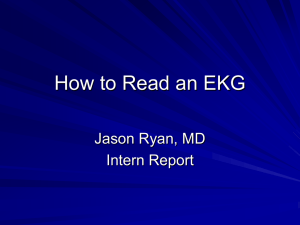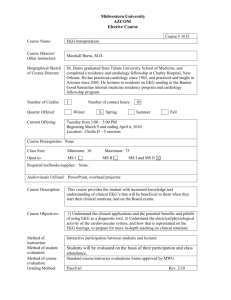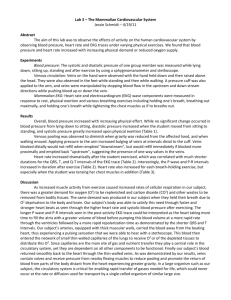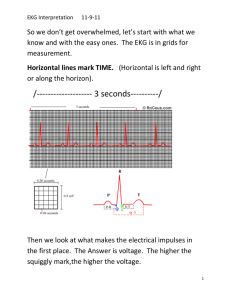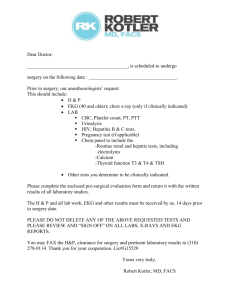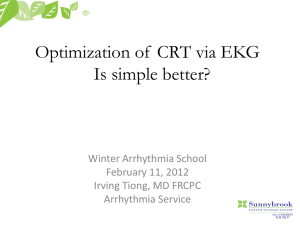Basic EKG Interpretation
advertisement
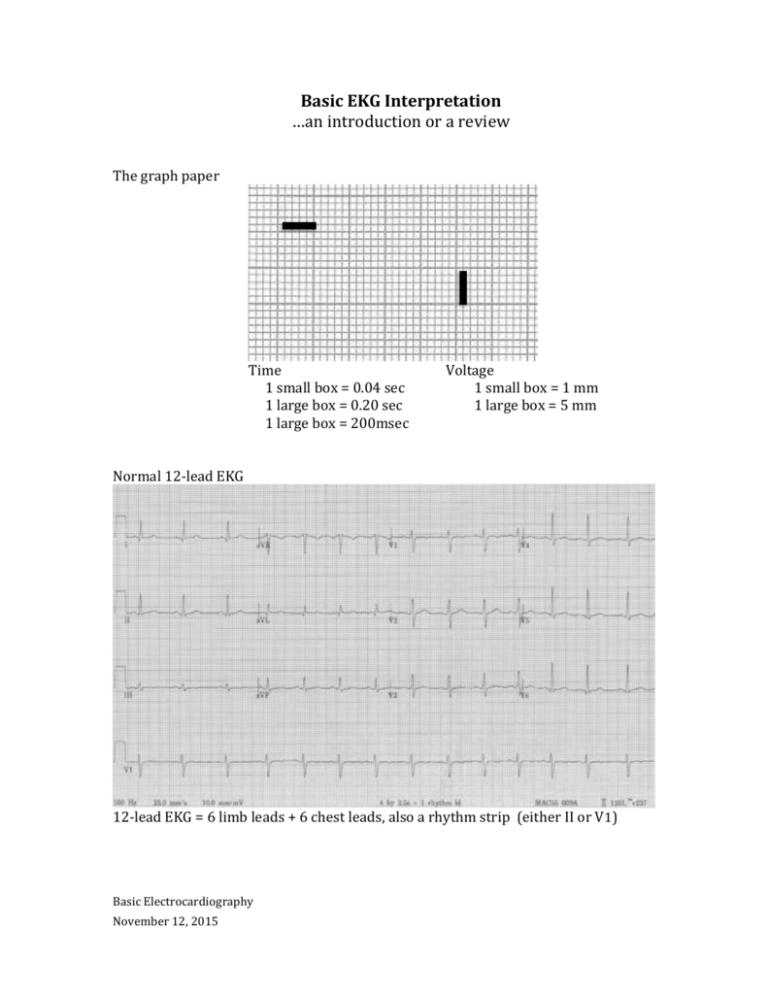
Basic EKG Interpretation …an introduction or a review The graph paper Time 1 small box = 0.04 sec 1 large box = 0.20 sec 1 large box = 200msec Voltage 1 small box = 1 mm 1 large box = 5 mm Normal 12-lead EKG 12-lead EKG = 6 limb leads + 6 chest leads, also a rhythm strip (either II or V1) Basic Electrocardiography November 12, 2015 3 standard limb leads were the first Then augmented leads Finally chest leads If current is moving toward a + electrode a positive wave is inscribed If current is moving away from a + electrode a negative wave is inscribed If current is perpendicular to + electrode an isoelectric line is inscribed Basic EKG Interpretation 2 Rhythm Sinus rhythm - upright P wave before every QRS Sinus bradycardia Sinus tachycardia Atrial fibrillation with RVR (rapid ventricular response) - irregularly irregular rhythm, fast if untreated Atrial flutter with 4:1 conduction Basic EKG Interpretation 3 2:1 Atrial flutter (approx. rate of 150/min) SVT at 180/minute Ventricular tachycardia 1° AV block 2° AV block, type I (Wenckebach) 3° AV block (Complete heart block) Basic EKG Interpretation 4 Rate Rate rule – if R-R complexes are 1 large box apart, rate = 300/min. And 300 divided by the # of large boxes between complexes = the rate. 300 – 150 – 100 – 75 – 60 - 50 250 136 94 71 300 214 150 125 100 88 75 68 187 115 83 65 167 107 79 62 60 50 43 Axis Intervals PR – normal < 200msec (0.20sec) - see AV blocks under rhythms 1° - PR > 200msec 2° - there is a dropped beat (P with no following QRS) type I – prolongation of each PR interval under beat is dropped type II – one or more P waves with no following QRS 3° - P waves that do not conduct to ventricles, QRS at different rate Basic EKG Interpretation 5 QRS – normal is 80-100msec (0.08-0.10 sec) When prolonged in sinus rhythm (QRS >100 – 120msec)… RBBB LBBB Severe LVH Hyperkalemia TCA toxicity Wolff-Parkinson-White syndrome Hypothermia RBBB LBBB - QRS ≥ 0.11s - rSR´ in V1 ( or, a tall R in V1) - wide terminal S wave in V6 (and lateral leads) - QRS > 0.12s - monophasic R wave in V6 - absence of septal q waves QT – varies, but proportional to the preceding R-R interval - normal QTc should be ≤ 500msec or < ½ the preceding R-R Chamber Enlargement - Left ventricular hypertrophy - deepest S in V1-2 + tallest R in V5-6 > 35mm, or - R in aVL > 12mm (especially with left axis deviation) - associated criteria - strain pattern in lateral leads - left axis deviation - eventually, QRS widening and poor R wave progression Right ventricular hypertrophy - tall R wave in V1 - right axis deviation Right atrial enlargement - tall, peaked P waves (> 2.5mm in II, III, or aVF) - prominent positive initial deflection in V1 Left atrial enlargement - wide, notched P in I, II, or aVL (> 0.12s) - large. negative terminal deflection in V1 Basic EKG Interpretation 6 Ischemia and Infarct Evolution of transmural MI 1. hyperacute T waves - within minutes after onset of acute occlusion - transient 2. giant R waves - “tombstones” 3. ST segment elevation - begin to decrease within 6 hours after onset (faster after reperfusion) - most subside within few days – if persist after weeks consider aneurysm - may see reciprocal changes in opposite leads 4. T wave inversion - begin to develop as ST segments return to baseline - remain for days to weeks 5. abnormal Q waves - begin to develop in 6-12 hours, sooner with intervention - usually persist indefinitely Basic EKG Interpretation 7 1 Basic EKG Interpretation 8 2 Basic EKG Interpretation 9 3 Basic EKG Interpretation 10 4 Basic EKG Interpretation 11 5 Basic EKG Interpretation 12 6 Basic EKG Interpretation 13 7 Basic EKG Interpretation 14 8 Basic EKG Interpretation 15 9 Basic EKG Interpretation 16 10 Basic EKG Interpretation 17 11 Basic EKG Interpretation 18 12 Basic EKG Interpretation 19 13 Basic EKG Interpretation 20 14 Basic EKG Interpretation 21 15 Basic EKG Interpretation 22 16 Basic EKG Interpretation 23 17 Basic EKG Interpretation 24 18 Basic EKG Interpretation 25 19 Basic EKG Interpretation 26 20 Basic EKG Interpretation 27 Interpretation and discussion points for EKGs 1. 2. 3. 4. 5. 6. 7. 8. 9. 10. 11. 12. 13. 14. 15. 16. 17. 18. Atrial fibrillation with ventricular response of 84/minute, left axis deviation (-60°), QRS slightly wide at 110msec, voltage for LVH with many associated findings – strain pattern of T wave inversion laterally, left axis, prolonged QRS, poor R wave progression Narrow-complex tachycardia at 150/minute 2:1 flutter 2° AV block, type I (Wenckebach), heart rate 36/min. hyperacute T waves inferiorly (II, III, aVF) and reciprocal changes V1-3 (?posterior infarct) – an acute inferiorposterior STEMI 3° AV block (complete heart block) with ventricular escape 18/minute. Note – P waves at 130/minute but not communicating to ventricles Atrial flutter with variable block, average rate 120/min, axis normal, QRS and QT normal. Sinus at 108/min, right axis deviation, tall R in V1 Right Ventricular Hypertrophy (RVH)…in a person with pulmonary hypertension. Sinus at 72/minute, normal axis, QRS wide at 0.12sec with tall R wave in V1 RBBB, also wide terminal S wave in I, aVL, and V6; no ischemia Sinus at 66/min, left axis deviation, QRS 0.16sec with tall monophasic R wave in I, aVL, and V6 LBBB with plenty of expected repolarization changes like ST elevation in V1-3 and ST depression, T wave inversion in I, aVL, and V5-6. Rate 72/minute, probably sinus but no obvious P waves; wide QRS with peaked T waves V3-5 severe hyperkalemia. Sinus tachycardia at 102/min, normal axis, QRS slightly wide at 0.11sec, QT wide, R wave in aVR ≥ 3mm TCA toxicity Sinus at 66/min, axis -30°, PR short (0.12sec), QRS wide, and delta wave between the P and QRS Wolff-Parkinson-White syndrome/ Sinus bradycardia at 48/min, normal axis, QRS wide with added wave at end of QRS complexes – the Osborne wave of hypothermia. Rate 78/min, P waves are inverted in inferior leads (II, III, and aVF) suggesting a junctional or low atrial ectopic focus; normal PR and QRS intervals, prolonged QT interval – a patient with new renal failure and hypocalcemia. Sinus at 84/minute, normal axis, PR and QRS are normal, QR interval is very short hypercalcemia (in a patient with metastatic adenoCa and hypercalcemia). Sinus at 126/min, right axis deviation, intervals normal, tall R in V1 with right axis RVH; also note wide R in II and terminal P inversion in V1 (left atrial enlargement); RVH and LAE mitral stenosis Sinus at 114/min, axis 90°, tall peaked P waves in inferior leads (II, III, avF) consistent with “P pulmonale” or right atrial enlargement; also the essentially isoelectric complexes in I are consistent with COPD. Atrial fibrillation at 102/min, diffuse ST segment depression in multiple leads diffuse ischemia in a patient with left main stenosis. Sinus at 72/min, axis -30°, intervals normal, hyperacute T waves in V2-4 with reciprocal changes (ST depression and T wave inversion) in inferior leads (II, III, aVF) an acute anterior MI. Basic EKG Interpretation 28 19. 20. Sinus at 84/min, axis normal, intervals normal, ST segment elevation in II, III, and aVF with reciprocal ST segment depression in I and aVL consistent with acute inferior MI. Sinus at 108/min, normal axis, intervals normal, ST elevation in V1-4 with biphasic T waves – an evolving transmural infarct. This handout and the PowerPoint presentation is on a new website: www.TorreyEKG,com -- follow new posts to the website with @STorreyMD Basic EKG Interpretation 29

